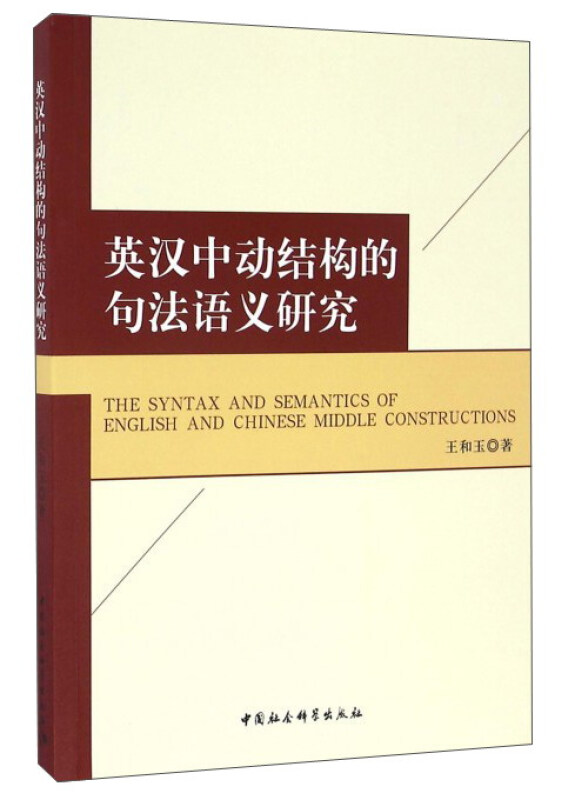
包邮英汉中动结构的句法语义研究

温馨提示:5折以下图书主要为出版社尾货,大部分为全新(有塑封/无塑封),个别图书品相8-9成新、切口有划线标记、光盘等附件不全详细品相说明>>
- ISBN:9787516190234
- 装帧:暂无
- 册数:暂无
- 重量:暂无
- 开本:32开
- 页数:287页
- 出版时间:2016-11-01
- 条形码:9787516190234 ; 978-7-5161-9023-4
内容简介
《英汉中动结构的句法语义研究》是在生成句法理论框架下对英汉中动结构的简探索。 中动结构关涉不同句式,呈现独特的句法语义特点。 如何将表面不同的各种句式纳入统一的句法结构,并且将其句法语义特点大程度地在结构上进行诠释?该研究尝试回答四个问题:(Ⅰ)中动句的语法主语为何不允准施事论元?(Ⅱ)中动句“修饰语要求”的实质是什么?(Ⅲ)何种句法机制使得中动句体现非事件性?(Ⅳ)中动句的话题效果和评价意义在句法上何以体现?
目录
Chapter One General Introduction
1.1 A Brief Survey of Middles
1.2 Syntactic and Semantic Properties of Middles
1.3 Identifying Middles in English and Chinese
1.4 A Critical Review of Syntactic Study on Middles
1.4.1 The Lexical Approach
1.4.2 The Syntactic Approach
1.4.3 The Parameterized Approach
1.4.4 The Minimalist Approach
1.4.5 The Semantic Approach
1.4.6 Summary
1.5 Research Questions
1.6 Overview of Our Core Assumptions
I.7 Layout of the Book
Chapter Two Theoretical Preliminaries
2.1 Type and Token
2.2 Theta Features and Syntactic Derivation
2.3 Feature Inheritance from C to T
2.4 Agree
2.4.1 Agr as Functional Heads
2.4.2 Agree as Local Syntactic Relation
2.4.3 A Feature-Sharing Version of Agree
2.5 Summary
Chapter Three A [uC]-Featured verb Analysis of Middle Predicates
3.1 Theta Relations and Syntactic Derivation
3.1.1 Lexicalist vs.Non-Lexicalist Debate
3.1.2 Theta Roles as Theta Features
3.l.3 The Light verb and Theta Features
3.1.4 Valuing Theta Features in SD
3.1.5 Summing Up
3.2 Theta Relations in Middle Predicates
3.2.1 The Responsibility Reading and Causative Analysis
3.2.2 A [ uC] -Feature verb Analysis
3.2.3 Merits of the [ uC] -Featured verb Analysis
3.3 English Middles Under the [ uC]-Featured verb Analysis
3.3.1 Patient-Subject Middles
3.3.2 Adjunct-Subject Middles
3.3.3 Agent as Non-External Argument
3.3.4 Summing Up
3.4 Chinese Middles Under the [ uC] -Featured verb Analysis
3.4.1 Patient-Subject Middles
3.4.2 Adjunct-Subject Middles
3.4.3 Middle Status of "NP + V-qilai + AP" Constructions
3.4.4 Summing Up
3.5 Extension of the [ uC]-Featured verb Analysis
3.5.1 Other Constructions Involving the [ uC] -Featured verb
3.5.2 Reflexive Middies in Romanic Languages
3.5.3 Middles and Ergatives
3.5.4 Reflection on the Voice Category
3.6 Summary
Chapter Four An [iMod]-Featured TMOD Analysis of Middle Clauses
4.1 Modals and TP
4.1.1 Significance of the Functional Category T
4.1.2 Modal Projection as TP
4.1.3 Modal Auxiliaries as an [ iMod] -Featured Defective TMOD
4.2 TMOv and the Davidsonian Event Argument in Middle Clauses
4.2.1 The Davidsonian Event Argument
4.2.2 Licensing Condition of the Davidsonian Event Argument
4.2.3 Suppression of the Event Argument by the [iMOD] -Featured TMOD
4.3 Modality in Middle Clauses
4.3.1 Definition and Classification of Modality
4.3.2 Epistemic and Root Modality
4.3.3 Modality Realization in Middle Clauses Through Agree
4.4 [ iMOD]-Featured TMoD Analysis of English and Chinese Middle Clauses
4.4.1 TMOD Analysis of English Middle Clauses
4.4.2 TMOo Neng/Ke (can) in "NP + Neng/Ke + V" Sentences
4.4.3 TMoo Hao (good) in the "NP + Hao + V" Construction
4.4.4 TMOD Nan/Yi (difficult~easy) in "NP + Nan/Yi + V" Sentences
4.4.5 The Null TMOD in the "NP + V-qilai + AP" Construction
4.4.6 Summing Up
4.5 Extension of the [ iMOD]-Featured TMD Analysis
4.5.1 Episodic Middles in English and Chinese
4.5.2 Notional Passives in Chinese
4.5.3 Reflection on the English Tense System
4.6 Summary
Chapter Five The Topic Effect in Middle Constructions
5.1 Topic Status of the Sentence-Initial NPs in Middle Clauses
5.1.1 Categorical Sentence vs.Thctic Sentence
5.1.2 Individual Level Predicates vs.Stage Level Predicates
5.1.3 Middles as Categorical Sentences and Individual Level Clauses
5.1.4 Participant Topic and TMoD
5.2 Feature DONATE from C to TMoD in the Middle Structure
5.2.1 Feature Inheritance Mechanism
5.2.2 Feature DONATE in Derivation of the Middle Structure
5.2.3 Combination of A-Movement and A' -Movement
5.2.4 Overlap of Categorical Topic and Grammatical Subject
5.3 Middle Clauses as Topic Sentences
5.3.1 English Middle Clauses as Topic Sentences
5.3.2 Chinese Middle Constructions as Topic Sentences
5.4 Advantages of the Topicalization Analysis
5.5 Extension of the Topicalization Analysis
5.5.1 Dissolving Impersonal Middle Clauses
5.5.2 Reflection on the Subject vs.Topic Debate
5.6 Summary
Chapter Six The Adverbial Requirement in Middle Constructions
6.1 Previous Accounts for the Adverbial Requirement
6.1.1 Adverbial Requirement as an Intriguing Problem
6.1.2 Various Perspectives to the Adverbial Requirement
6.1.3 Critical Evaluation
6.2 Our Account——A Semantic and Morph-Syntactical Requirement
6.2.1 Adverbial Appearance as Effect of the [ uC] -Featured Light verb
6.2.2 Modal, Negation, Focus as Semantic Operators in the T-Domain
6.2.3 Morpho-Syntactic Realization of the Semantic Operators
6.2.4 Summing Up
6.3 Adverbials in English Middle Constructions
6.3.1 The Allowable Adverbials
6.3.2 Re-Examining the Subtypes
6.4 Are Adverbials Required in Chinese Middle Constructions?
6.4.1 Overt TMOD as Morpho-Syntactic Operators
6.4.2 An Adjectival Requirement in the "NP + V-qilai + AP" Construction
6.4.3 Summing Up
6.5 Reflection on Merger of Adverbials
6.6 Summary
Chapter Seven Conclusion
7.1 Summarizing the Syntax and Semantics of Middle Constructions
7.2 Significance of the Study
7.3 Limitations and Questions for Further Research
References
List of Abbreviations
作者简介
王和玉(1974-),湖南常德人,广东工业大学外国语学院副教授,句法学博士。先后赴澳大利亚昆士兰大学(University of Queensland)和美国马里兰大学(University of Maryland)访学。参与国家社科项目“零形素句法研究”和教育部人文社科项目“现代汉语时间指称的句法研究”,主持广东省哲社规划项目“语态现象与动词及物性的*简句法阐释”和广东工业大学高教研究基金项目“东西方文化课程群建设”。
-

学科核心素养的养成:高中学科思想方法与教学有效融合的探究
¥37.0¥48.0 -

智能电网实时电价定价策略
¥41.8¥68.0 -

21世纪经济管理精品教材-经济学系列-【能源经济学】-第二版
¥23.0¥45.0 -

中国古代史学批评史.第二卷--中国古代史学批评的初步发展(魏晋南北朝时期)
¥116.6¥162.0 -

深度学习方法在滚动轴承故障识别中的应用
¥18.4¥58.0 -

绿色低碳城市更新技术指南
¥55.6¥78.0 -

Python数据分析实战;数据采集、分析及可视化;微课视频版
¥42.3¥49.8 -

1岁全脑开发
¥12.9¥19.8 -

电子商务基础与实务 (第二版)
¥12.0¥19.0 -

当代中国法治指数报告(2020—2023)
¥71.9¥109.0
-

文言浅说
¥11.0¥24.0 -

饥饿、富裕与道德
¥12.2¥45.0 -

偏见
¥21.8¥56.0 -

乡土中国
¥18.5¥26.0 -

一个西方传教士的长征亲历记
¥15.7¥49.0 -

从白大褂到病号服:探索医疗中的人性落差
¥13.7¥39.8 -

人际交往心理学
¥10.5¥38.0 -

蛤蟆先生去看心理医生
¥23.8¥38.0 -

西方哲学史
¥14.8¥38.0 -

女性生存战争
¥26.1¥66.0 -

性心理学
¥18.4¥58.0 -

社会学:原来这么有趣有用
¥10.0¥36.0 -

身为女性的选择
¥25.2¥56.0 -

乌合之众:群体心理研究
¥12.9¥39.8 -

中国人的名·字·号
¥10.0¥28.0 -

我们内心的冲突(平装)
¥13.8¥39.9 -

我们内心的冲突
¥14.4¥42.0 -

咬文嚼字二百问
¥13.2¥32.0 -

看不见的伤痕(八品-九品)
¥23.1¥69.0 -

蚂蚁社会
¥29.1¥78.0











